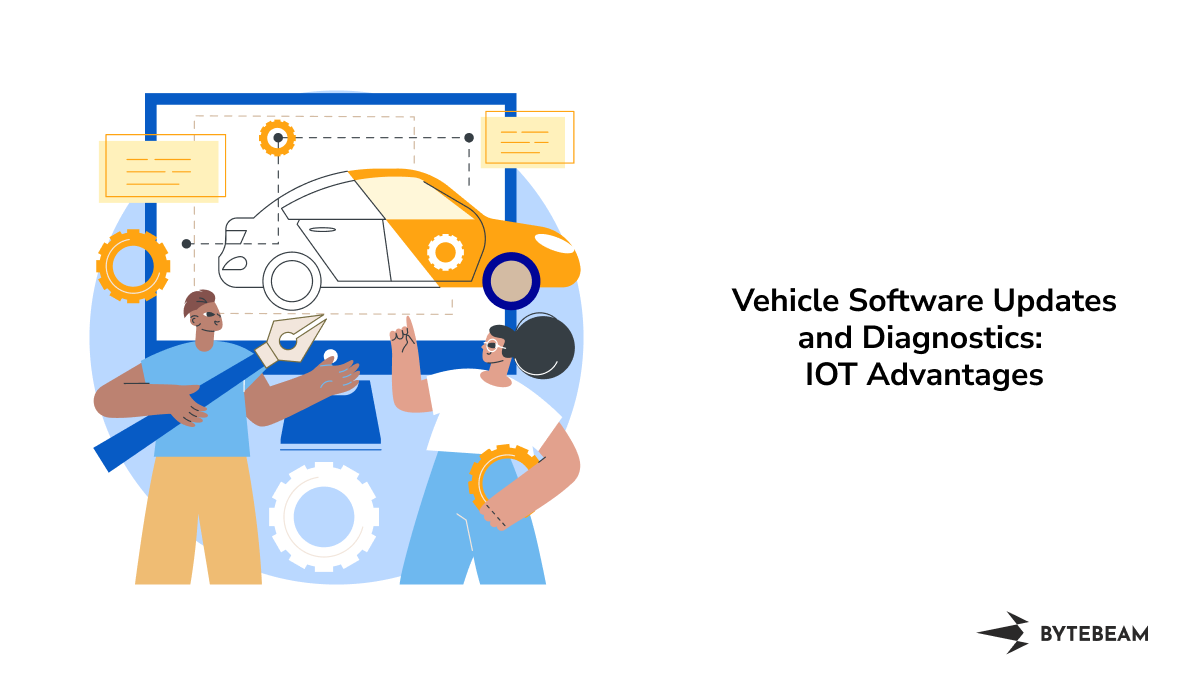Vehicle Software Updates and Diagnostics: The IoT Advantage

There is no denying that connected vehicles are here to stay. And IoT is playing a crucial role in it. Just look at some of these numbers:
- IoT-enabled vehicles can reduce fuel consumption by up to 20%. (McKinsey & Company)
- IoT-enabled vehicles can reduce traffic congestion by up to 40%. (Accenture)
- IoT-enabled vehicles can reduce the number of traffic accidents by up to 50%. (Boston Consulting Group)
These numbers clearly tell us that IoT is essential to the growth of connected vehicles. But IoT is especially transformative for vehicle software updates and diagnostics.
What to expect: In this article, we delve into the advantages that IoT brings to vehicle software updates and diagnostics.
Understanding IoT in the Automotive Landscape
IoT in vehicles connects devices and systems over the internet to collect, send, and receive data in real-time. This intricate network of sensors, software, and connectivity solutions enables vehicles to communicate with each other, as well as with external systems and infrastructure.
For example, IoT-enabled vehicles can communicate with each other to warn of traffic hazards or to coordinate platooning. They can also communicate with external systems, such as traffic lights or smart city infrastructure, to optimize traffic flow and reduce congestion. Additionally, IoT-enabled vehicles can collect data on their own performance and condition, which can be used to improve safety and reliability.
Why are Updates and Diagnostics Crucial?
Software updates and diagnostics may seem like an add-on feature in connected vehicles but they are crucial in modern vehicles. Not just for users, but manufacturers too.
Here's why they play such an essential role:
Safety
Updates: Software updates often contain patches to address vulnerabilities that could be exploited by malicious actors. By updating regularly, the system or vehicle remains protected from known threats.
Diagnostics: Real-time diagnostics can immediately detect malfunctions or suboptimal performance in critical systems, preventing accidents or further damages.
Optimal Performance
Updates: New software updates often come with improvements that optimize the performance of devices, systems, or vehicles. This can mean faster response times, more efficient energy usage, or enhanced features.
Diagnostics: Regular diagnostics ensure that all parts and systems are working at their optimal capacity. Identifying and addressing issues early can prevent them from escalating into larger problems.
Cost Efficiency
Updates: By incorporating the latest updates, users can avoid potential problems that could lead to costly repairs or replacements down the line.
Diagnostics: Proactive diagnostics can predict potential issues, allowing for preventive maintenance. This approach is often less costly than reactive repairs after a major breakdown.
User Experience
Updates: Software updates can introduce new features or improvements that enhance the user experience, making devices or systems more user-friendly, versatile, or efficient.
Diagnostics: With advanced diagnostics, users get a clearer picture of their system's or vehicle's health, which can lead to peace of mind and more informed decision-making regarding maintenance.
Longevity and Durability
Updates: Regular software updates ensure that a system or vehicle is equipped with the latest technological advancements, potentially extending its usability and relevance over time.
Diagnostics: Routine diagnostics and the resulting maintenance can extend the lifespan of a system or vehicle by ensuring that it's always in good working condition.
Regulatory and Compliance Reasons
In certain industries and regions, regular updates and diagnostics might be a requirement to comply with safety, environmental, or other regulatory standards.
Enhanced Features and Capabilities
Updates: Apart from fixes, updates often bring new functionalities or enhancements that add value to the user, keeping the product or system contemporary and competitive.
Staying Ahead of Threats
With the rise of cyber threats in the digital age, updates are a means to ensure systems have the latest security protocols, keeping them protected from evolving threats.
In essence, updates and diagnostics work hand-in-hand to ensure that systems, devices, and vehicles remain safe, efficient, and up-to-date, providing both immediate and long-term benefits to users and manufacturers alike.
Software Updates: The Over-the-Air Revolution
Traditional Approach: Previously, software updates required physical interventions. Vehicle owners had to visit service centers or dealerships to have the latest software installed, a process that was time-consuming and often inconvenient.
IoT-Enabled Updates: With the integration of IoT, software updates can now be transmitted over-the-air (OTA), which offers several benefits:
- Convenience for Owners: Updates can be downloaded and installed at the user's convenience, reducing downtime.
- Cost Efficiency: Eliminating the need for physical visits saves costs for both manufacturers and owners.
- Quick Bug Fixes: Any issues or vulnerabilities detected in the software can be fixed promptly, ensuring vehicle safety.
- Enhanced Features: Manufacturers can frequently release new features, enhancing the user experience.
Diagnostics: Proactive rather than Reactive
Traditional Diagnostics: In older models, vehicle issues were often identified after they became serious, often leading to major repairs and replacements.
IoT-Driven Diagnostics: Now, with IoT sensors embedded throughout the vehicle:
- Real-time Monitoring: Sensors continuously monitor vehicle performance and can detect anomalies immediately.
- Predictive Maintenance: By analyzing patterns and historical data, these systems can predict potential issues, allowing for preventive action.
- Detailed Insights: Instead of generic warning lights, drivers receive detailed information about the problem and possible solutions.
- Remote Troubleshooting: In some cases, minor software-related issues can be fixed remotely without the need for a service visit.
Safety and Security in the IoT Era
While the benefits of IoT in vehicles are significant, its integration also raises cybersecurity concerns. As vehicles become increasingly connected, the risk of cyberattacks grows. Manufacturers must prioritize robust cybersecurity measures to protect against potential threats. Features such as end-to-end encryption, intrusion detection systems, and regular security updates are essential.
The Way Forward: Collaborative Ecosystems
IoT has the potential to revolutionize vehicle software updates and diagnostics, but it requires a collaborative approach from vehicle manufacturers, software providers, and cybersecurity experts. Together, they can create a secure, efficient, and user-friendly ecosystem that will unlock the full potential of IoT in the automotive sector.
The intersection of the automotive world and IoT has paved the way for smarter, more efficient, and more self-reliant vehicles. As vehicles evolve into complex software-driven machines, IoT will play a critical role in ensuring that they function optimally. Embracing these changes offers a promising path forward for both manufacturers and vehicle owners.

